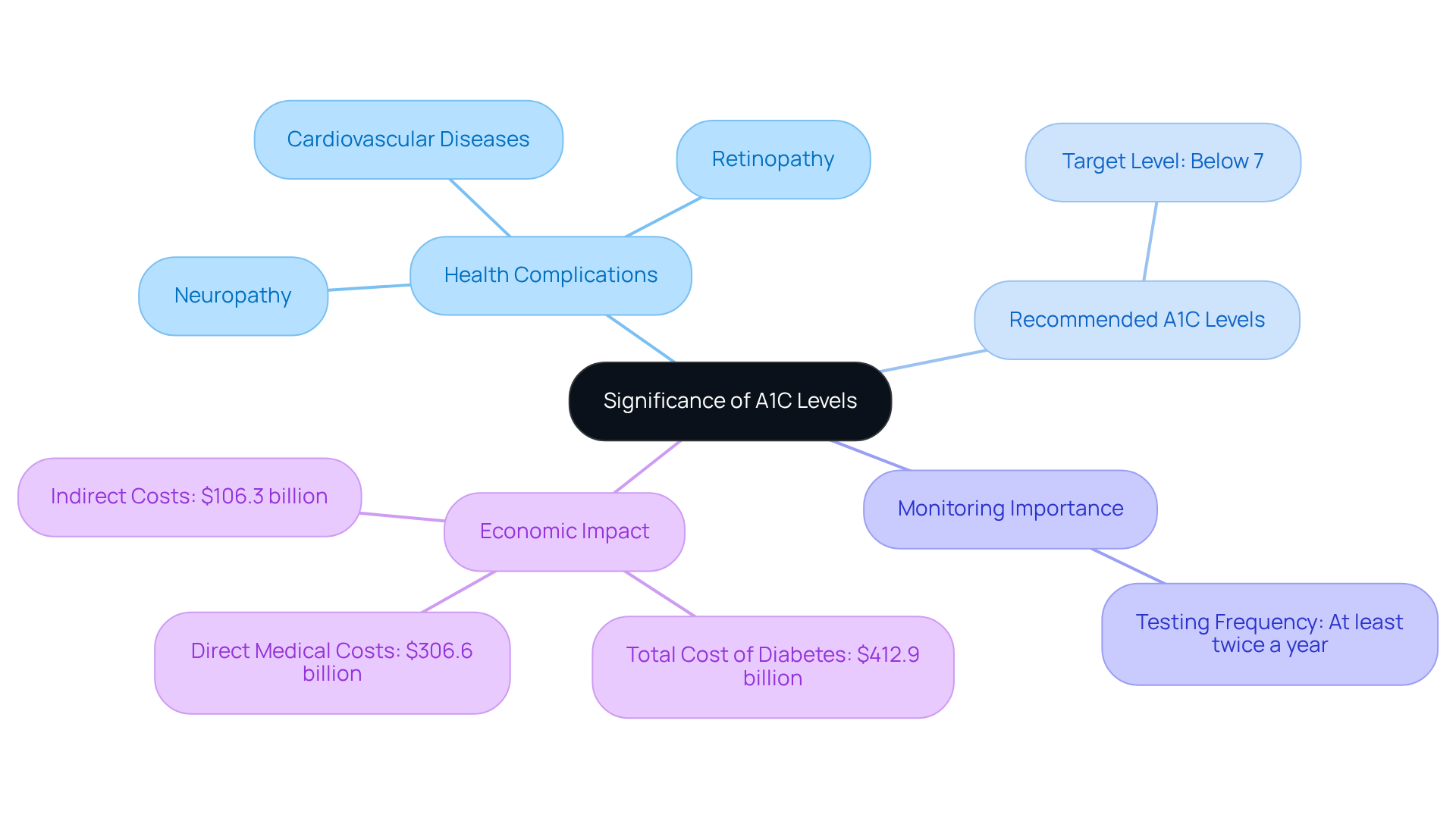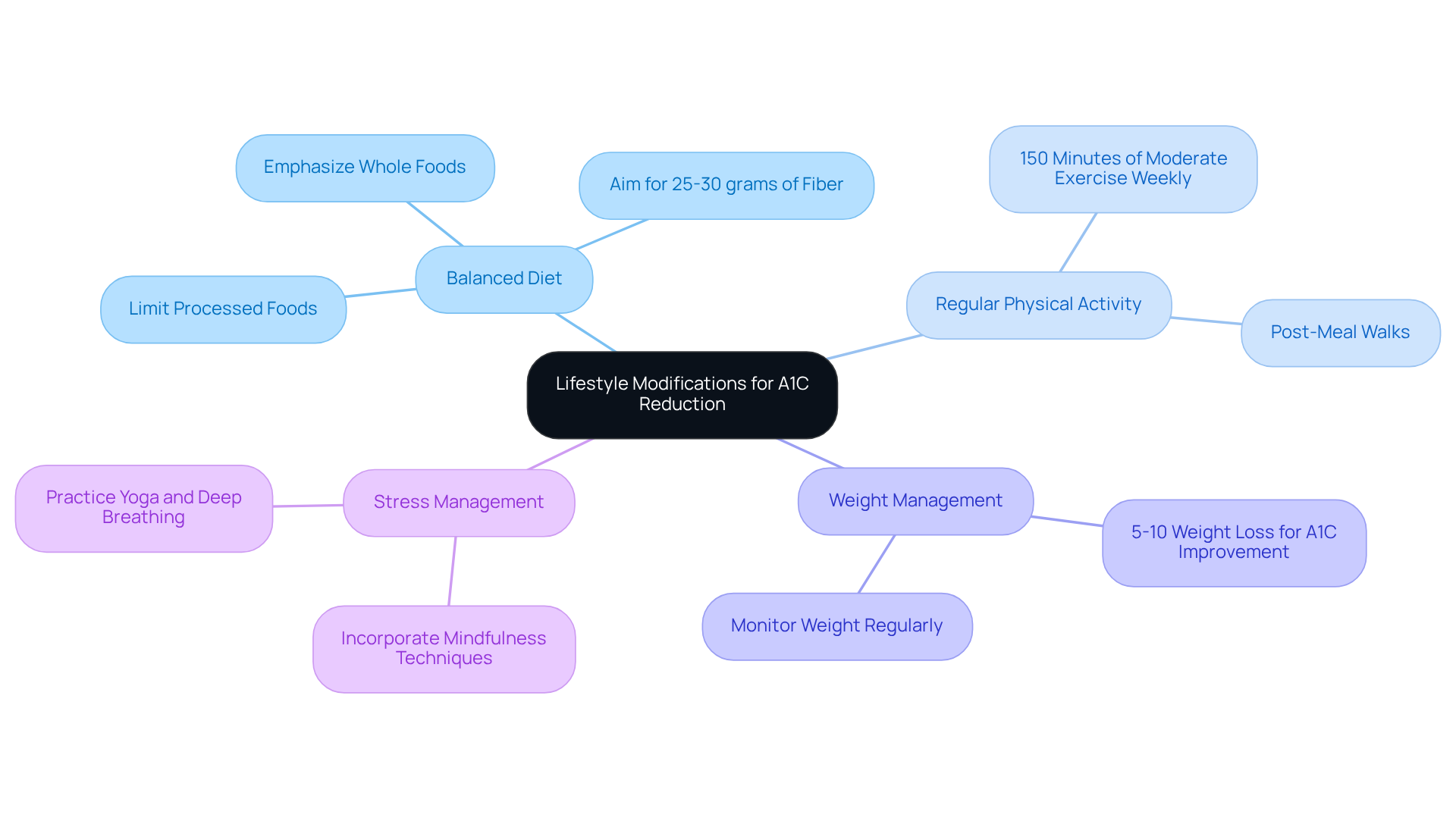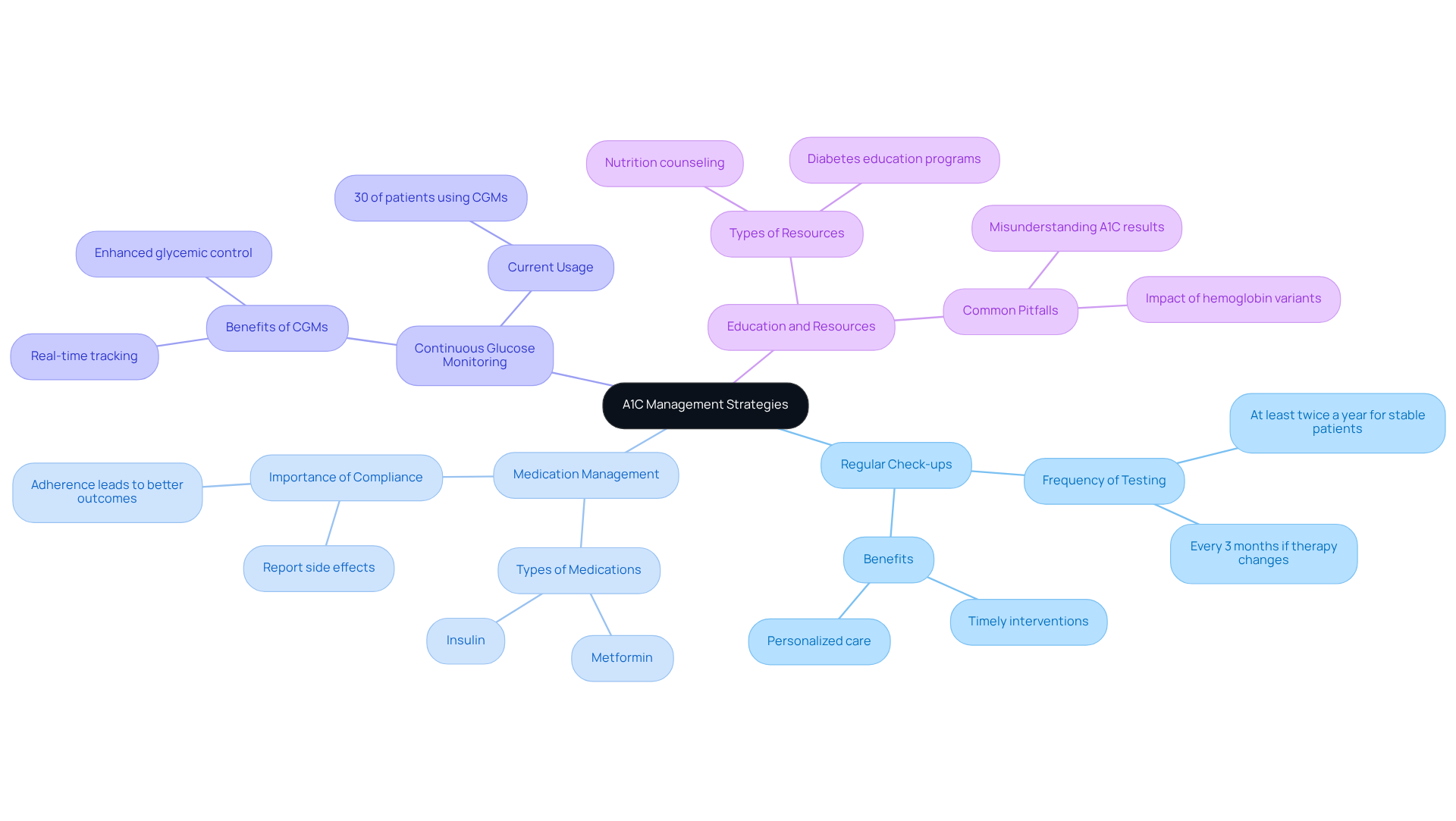Overview
This article highlights three essential strategies for effectively reducing A1C levels, which can feel daunting at times. By implementing lifestyle modifications, utilizing medical support, and engaging in regular monitoring, you can take meaningful steps towards better health. Evidence shows that a balanced diet, regular physical activity, weight management, and medical interventions can significantly improve A1C readings. This ultimately lowers the risk of diabetes-related complications, giving you peace of mind.
We understand that embarking on this journey can be overwhelming, but remember, you’re not alone. Together, we can achieve your goals. Consider how small changes in your daily routine—like incorporating more fruits and vegetables or finding an enjoyable form of exercise—can make a big difference. Regular check-ins with healthcare professionals can also provide the support you need to stay on track.
By embracing these strategies, you are taking a proactive approach to your health. Celebrate each step you take, no matter how small, and remind yourself that every effort counts. Together, we can navigate this path towards healthier A1C levels and a brighter future.
Introduction
Understanding and managing A1C levels is not just important; it’s essential for individuals living with diabetes. These readings serve as vital indicators of long-term blood sugar control, and we recognize that navigating this journey can feel overwhelming. By focusing on effective strategies to reduce A1C, you can significantly lower your risk of serious health complications while also enhancing your overall well-being. But what are the most effective lifestyle changes and medical interventions that can lead to meaningful improvements?
This article delves into three key strategies that empower you to take control of your health. Together, we can explore actionable insights that will help you achieve better A1C levels and foster a healthier, more fulfilling life. Remember, you’re not alone in this journey; we’re here for you every step of the way.
Understand the Significance of A1C Levels
A1C readings, also known as glycated hemoglobin, serve as a vital indicator of your average blood sugar levels over the past two to three months. If you are living with diabetes, it’s generally recommended to focus on reducing A1C readings to keep them below 7%. This goal can significantly lower your risk of serious complications, such as:
- Neuropathy
- Retinopathy
- Cardiovascular diseases
Research has shown that staying within this target range can greatly assist in reducing A1C and the likelihood of developing diabetes-related health issues.
Regularly monitoring your A1C readings is essential for reducing A1C levels. It not only provides valuable insights into the effectiveness of your current management strategies but also highlights the need for possible adjustments. According to the American Diabetes Association, it’s advisable for individuals with diabetes to undergo an A1C test at least twice a year to ensure effective management. By recognizing the importance of A1C values, you can take proactive steps towards reducing A1C to enhance your health outcomes and collaborate with your healthcare providers to optimize your treatment strategies.
Moreover, with the total cost of diagnosed diabetes in the United States reaching a staggering $412.9 billion in 2022, effective A1C management is crucial—not just for your personal health, but also for alleviating the economic burden associated with diabetes. Remember, together we can achieve your health goals, and we’re here to support you every step of the way.
Implement Lifestyle Modifications for A1C Reduction
To effectively reduce A1C levels, it’s important to focus on several key lifestyle modifications that can truly make a difference:
-
Balanced Diet: Emphasizing a diet rich in whole foods—think vegetables, lean proteins, whole grains, and healthy fats—can be transformative. It’s essential to limit processed foods and sweeteners, as these can lead to significant spikes in blood glucose. The Dietary Guidelines suggest aiming for at least 14 grams of fiber per 1,000 calories, with a total daily goal of 25-30 grams to support better glycemic control. Tara Seymour, an advanced practice clinical dietitian, reminds us, “Adopting a well-balanced diet, staying active, controlling your weight can put you in control, enabling you to arrest or even reverse the process.”
-
Regular Physical Activity: Engaging in at least 150 minutes of moderate aerobic exercise each week, such as brisk walking or cycling, can greatly enhance your health. Regular physical activity boosts insulin sensitivity and helps in reducing A1C by lowering blood glucose levels. Did you know that even a five-minute stroll after meals can significantly help regulate blood glucose?
-
Weight Management: Achieving and maintaining a healthy weight is crucial for enhancing A1C values. Research shows that even a modest weight loss of 5-10% can lead to substantial improvements in blood glucose management, comparable to certain anti-diabetic medications. In fact, losing just 5-10% of your weight can lower Hemoglobin A1C by half a point, similar to some medications. Many clients of Minimal report losing up to 20% of their weight, based on data from over 70,000 patients who participated for at least six months.
-
Stress Management: Chronic stress can take a toll on your blood sugar readings. Incorporating techniques such as mindfulness, yoga, and deep breathing exercises can effectively help manage stress, promoting better overall health.
By adopting these lifestyle modifications, you can create a supportive environment for reducing A1C and improving your overall health. These strategies not only contribute to better diabetes management but also align with a holistic approach to wellness. Remember, we’re here for you, and together, we can achieve your goals.
Utilize Medical Support and Regular Monitoring
Interacting with healthcare experts is crucial for effectively managing reducing A1C. Have you ever felt overwhelmed by the complexities of your health journey? Here are some best practices to help you navigate this path with confidence:
-
Regular check-ups are essential to arrange with your healthcare provider to track A1C figures and discuss any necessary modifications for reducing A1C in your treatment plan. The American Diabetes Association recommends that individuals with diabetes have their A1C checked at least twice a year if they are meeting treatment goals. These regular check-ups can significantly improve management outcomes, allowing for timely interventions and personalized care.
-
Medication Management: When lifestyle changes alone aren’t enough, your provider may prescribe medications such as metformin or insulin. Adhering to your provider’s recommendations and promptly reporting any side effects is crucial for optimizing treatment effectiveness. Exciting advancements in diabetes medications for 2025 provide new options that can further aid in reducing A1C. Remember, research shows that appropriate medication compliance can lead to notable enhancements in reducing A1C among patients.
-
Continuous Glucose Monitoring: Have you considered employing continuous glucose monitors (CGMs)? These devices deliver real-time tracking of blood glucose concentrations, offering valuable insights into how food, exercise, and stress affect your glucose measurements. Approximately 30% of patients are now using CGMs, which have been shown to enhance glycemic control and significantly reduce A1C levels. This technology empowers you to better understand and manage daily fluctuations in blood sugar.
-
Education and Resources: Leverage the educational resources provided by healthcare professionals, including nutrition counseling and diabetes education programs. These resources equip you with the knowledge needed to make informed health choices, ultimately aiding in reducing A1C. Additionally, being aware of common pitfalls, such as misunderstanding A1C results due to hemoglobin variants, can help you navigate your management strategies more effectively.
By utilizing medical support and committing to regular monitoring, you can enhance your ability to manage A1C levels effectively, which is crucial for reducing A1C and achieving your health goals. Remember, we’re here for you—together, we can achieve your goals.
Conclusion
Managing A1C levels is not just a task; it’s a vital part of diabetes care that significantly impacts your overall health and well-being. By understanding the importance of A1C readings and actively working to keep them below the recommended threshold, you can effectively reduce your risk of serious complications and enhance your quality of life. This journey requires personal commitment and collaboration with healthcare providers to optimize treatment strategies.
We want to share three essential strategies to help you reduce your A1C levels:
- Implementing lifestyle modifications
- Utilizing medical support
- Ensuring regular monitoring
Key lifestyle changes can include adopting a balanced diet rich in whole foods, engaging in regular physical activity, managing your weight, and practicing stress-reduction techniques. Additionally, seeking medical support through regular check-ups, medication management, and the use of continuous glucose monitoring can significantly enhance your A1C management efforts.
Ultimately, the significance of managing your A1C extends beyond your individual health; it also plays a crucial role in reducing the broader economic burden of diabetes. By taking proactive steps and seeking support, you can achieve your personal health goals and inspire others to prioritize their diabetes management as well. Embracing these strategies creates a pathway toward better health outcomes and a more empowered approach to living with diabetes. Remember, together, we can achieve your goals and foster a healthier future.
Frequently Asked Questions
What are A1C levels and why are they significant?
A1C levels, also known as glycated hemoglobin, indicate your average blood sugar levels over the past two to three months. They are significant because they help monitor diabetes management and the risk of complications.
What is the recommended target A1C level for individuals with diabetes?
It is generally recommended for individuals with diabetes to keep their A1C readings below 7% to lower the risk of serious complications such as neuropathy, retinopathy, and cardiovascular diseases.
How can monitoring A1C levels benefit individuals with diabetes?
Regularly monitoring A1C levels provides insights into the effectiveness of current management strategies and highlights the need for possible adjustments, helping to reduce A1C levels and improve health outcomes.
How often should individuals with diabetes get an A1C test?
The American Diabetes Association advises individuals with diabetes to undergo an A1C test at least twice a year to ensure effective management.
What is the economic impact of diabetes management related to A1C levels?
Effective A1C management is crucial not only for personal health but also for alleviating the economic burden of diabetes, which reached $412.9 billion in the United States in 2022.
How can individuals take proactive steps towards managing their A1C levels?
By recognizing the importance of A1C values, individuals can collaborate with healthcare providers to optimize treatment strategies and take proactive steps to reduce their A1C levels.




















